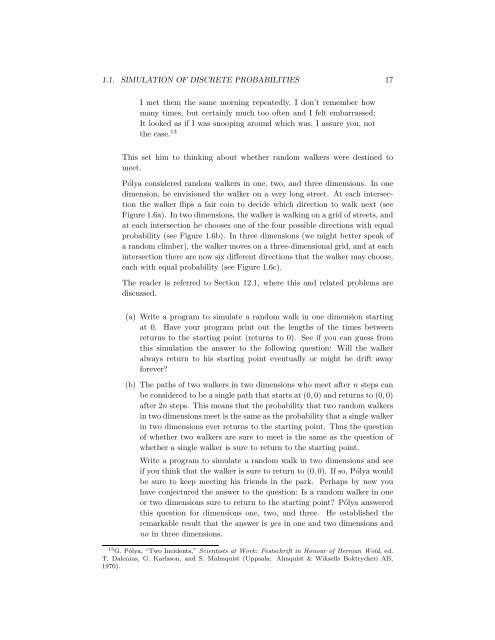Chapter 1 Discrete Probability Distributions - DIM
Chapter 1 Discrete Probability Distributions - DIM
Chapter 1 Discrete Probability Distributions - DIM
- No tags were found...
You also want an ePaper? Increase the reach of your titles
YUMPU automatically turns print PDFs into web optimized ePapers that Google loves.
1.1. SIMULATION OF DISCRETE PROBABILITIES 17I met them the same morning repeatedly, I don’t remember howmany times, but certainly much too often and I felt embarrassed:It looked as if I was snooping around which was, I assure you, notthe case. 13This set him to thinking about whether random walkers were destined tomeet.Pólya considered random walkers in one, two, and three dimensions. In onedimension, he envisioned the walker on a very long street. At each intersectionthe walker flips a fair coin to decide which direction to walk next (seeFigure 1.6a). In two dimensions, the walker is walking on a grid of streets, andat each intersection he chooses one of the four possible directions with equalprobability (see Figure 1.6b). In three dimensions (we might better speak ofa random climber), the walker moves on a three-dimensional grid, and at eachintersection there are now six different directions that the walker may choose,each with equal probability (see Figure 1.6c).The reader is referred to Section 12.1, where this and related problems arediscussed.(a) Write a program to simulate a random walk in one dimension startingat 0. Have your program print out the lengths of the times betweenreturns to the starting point (returns to 0). See if you can guess fromthis simulation the answer to the following question: Will the walkeralways return to his starting point eventually or might he drift awayforever?(b) The paths of two walkers in two dimensions who meet after n steps canbe considered to be a single path that starts at (0, 0) and returns to (0, 0)after 2n steps. This means that the probability that two random walkersin two dimensions meet is the same as the probability that a single walkerin two dimensions ever returns to the starting point. Thus the questionof whether two walkers are sure to meet is the same as the question ofwhether a single walker is sure to return to the starting point.Write a program to simulate a random walk in two dimensions and seeif you think that the walker is sure to return to (0, 0). If so, Pólya wouldbe sure to keep meeting his friends in the park. Perhaps by now youhave conjectured the answer to the question: Is a random walker in oneor two dimensions sure to return to the starting point? Pólya answeredthis question for dimensions one, two, and three. He established theremarkable result that the answer is yes in one and two dimensions andno in three dimensions.13 G. Pólya, “Two Incidents,” Scientists at Work: Festschrift in Honour of Herman Wold, ed.T. Dalenius, G. Karlsson, and S. Malmquist (Uppsala: Almquist & Wiksells Boktryckeri AB,1970).
















